
Trigonometric equations. Main methods for solving
 المؤلف:
المرجع الالكتروني للمعلوماتيه
المؤلف:
المرجع الالكتروني للمعلوماتيه
 المصدر:
www.almerja.com
المصدر:
www.almerja.com
 الجزء والصفحة:
...
الجزء والصفحة:
...
 13-2-2017
13-2-2017
 5333
5333
Trigonometric equations. Main methods for solving
Trigonometric equations. Simplest trigonometric equations.
Methods of solving: algebraic method, factoring, reducing
to a homogeneous equation, transition to a half-angle,
introducing an auxiliary angle, transforming a product to
a sum, universal substitution.
Trigonometric equations. An equation, containing an unknown under the trigonometric function sign is called trigonometric.
Simplest trigonometric equations.
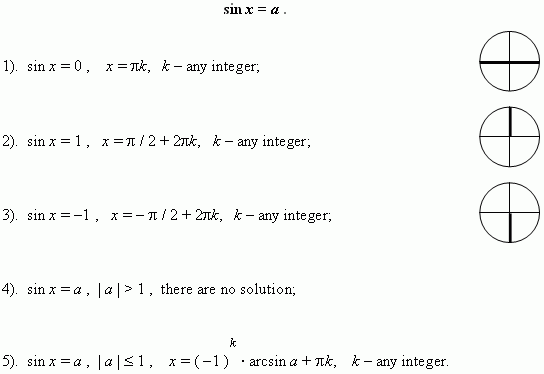


Methods for solving trigonometric equations. Solving of a trigonometric equation consists of the two stages: transforming of a equation to receive its simplest shape ( see above ) and solving of the received simplest trigonometric equation. There are seven main methods of solution of trigonometric equations.
1. Algebraic method. This method is well known for us from algebra ( exchange and
substitution method ).
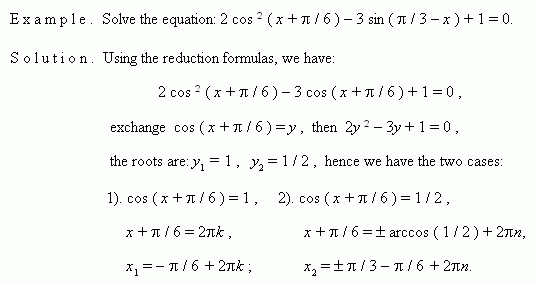
2. Factoring. Consider this method by examples.
E x a m p l e 1. Solve the equation: sin x + cos x = 1 .
S o l u t i o n . Transfer all terms to the left:
sin x + cos x – 1 = 0 ,
transform and factor the left-hand side expression:

E x a m p l e 2. Solve the equation: cos² x + sin x · cos x = 1.
S o l u t i o n . cos ² x + sin x · cos x – sin ² x – cos ² x = 0 ,
sin x · cos x – sin ² x = 0 ,
sin x · ( cos x – sin x ) = 0 ,
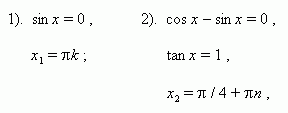
E x a m p l e 3. Solve the equation: cos 2x – cos 8x + cos 6x = 1.
S o l u t i o n . cos 2x + cos 6x = 1 + cos 8x ,
2 cos 4x cos 2x = 2 cos ² 4x ,
cos 4x · ( cos 2x – cos 4x ) = 0 ,
cos 4x · 2 sin 3x · sin x = 0 ,
1). cos 4x = 0 , 2). sin 3x = 0 , 3). sin x = 0 ,

|
3.
|
Reducing to a homogeneous equation. An equation is called a homogeneous equation in sin and cos, if and only if all its terms are of the same degree in sin and cos of the same angle.
To solve the homogeneous equation it is necessary:
a) to transfer all terms to the left-hand side;
b) to take all common factors out of brackets;
c) to equate all factors and brackets to zero;
d) the brackets equated to zero give the homogeneous equation of the smaller
degree, which should be divided by cos ( or sin ) of the higher power;
e) to solve the received algebraic equation in tan .
E x a m p l e . Solve the equation: 3 sin ² x + 4 sin x · cos x + 5 cos ² x = 2.
S o l u t i o n . 3 sin ² x + 4 sin x · cos x + 5 cos ² x = 2sin ² x + 2cos ² x ,
sin ² x + 4 sin x · cos x + 3 cos ² x = 0 ,
tan ² x + 4 tan x + 3 = 0 , hence y ² + 4y +3 = 0 ,
the roots of this equation are: y1 = –1 , y2 = –3 , from here
1) tan x = –1, 2) tan x = –3,

|
4. Transition to a half-angle. Consider this method by the example:
E x a m p l e . Solve the equation: 3 sin x – 5 cos x = 7.
S o l u t i o n . 6 sin ( x / 2 ) · cos ( x / 2 ) – 5 cos ² ( x / 2 ) + 5 sin ² ( x / 2 ) =
= 7 sin ² ( x / 2 ) + 7 cos ² ( x / 2 ) ,
2 sin ² ( x / 2 ) – 6 sin ( x / 2 ) · cos ( x / 2 ) + 12 cos ² ( x / 2 ) = 0 ,
tan ² ( x / 2 ) – 3 tan ( x / 2 ) + 6 = 0 ,
. . . . . . . . . .
5. Introducing an auxiliary angle. Consider an equation of the shape:
a sin x + b cos x = c ,
where a, b, c – coefficients; x – an unknown.

New coefficients in the left-hand side have the properties of sine and cosine: a modulus
( absolute value ) of each of them is not more than 1, and a sum of their squares is equal
to 1. So, we can mark them as cos φ and sin φ correspondingly; here  is the so called
is the so called
an auxiliary angle.
Now our equation has the shape:


6. Transforming a product to a sum. The corresponding formulas are used here.
E x a m p l e . Solve the equation: 2 sin 2x · sin 6x = cos 4x.
S o l u t i o n . Transform the left-hand side to the sum:
cos 4x – cos 8x = cos 4x ,
cos 8x = 0 ,

7. Universal substitution. Consider this method by example.
E x a m p l e . Solve the equation: 3 sin x – 4 cos x = 3 .
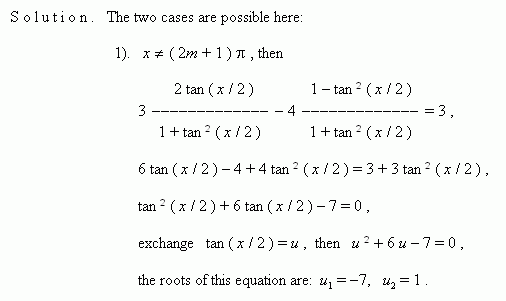
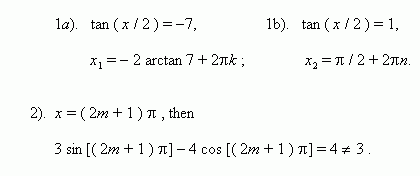
So, only the first case gives the solution.
 الاكثر قراءة في المثلثات
الاكثر قراءة في المثلثات
 اخر الاخبار
اخر الاخبار
اخبار العتبة العباسية المقدسة


